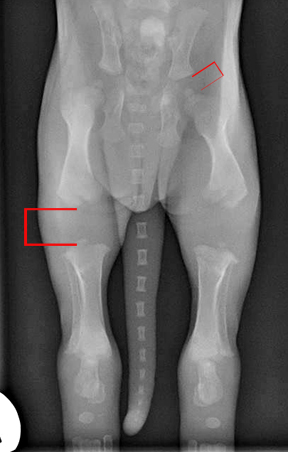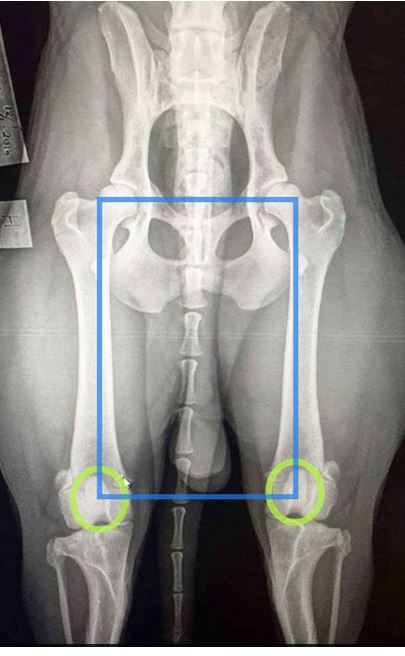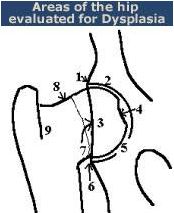
Hips, Elbows & Patellas
Hips, Elbows & Patellas
Do Collies Have Hip And Elbow Problems?
Neither hip nor elbow dysplasia are considered a significant problem in Collies therefore screening by breeders is relatively low however knowing the rating of breeding stock is still a useful tool in screening. By screening, breeders can be aware of the structure of breeding stock that cannot be determined by a visual examination.
Hip and elbow dysplasia are considered to be polygenic issues (involving multiple genes) and it is not known how those genes are transmitted to effect future generations. Even though there is not a clear pattern of transmission, it only makes sense to eliminate dysplastic dogs from the gene pool.
There is increasing research showing that the activity and weight of a growing puppy can have an impact on the development and functionality of hip and elbow health as an adult. It is possible for a puppy from parents with acceptable ratings to develop a problem if the puppy is kept too heavy and receives the wrong type of exercise when young. Below is an image of a 2 week old puppy showing the huge gaps in the skeletal structure at that age.

How Do You Test For Hip Dysplasia?
Understanding Hip and Elbow dysplasia and how the potential for problems is transmitted is an evolving field with new information offering opportunities to avoid the problem as well as ways to alleviate pain upon diagnosis.
We have options to screen by x-ray and to have the results examined by professionals to receive ratings on the results found. Two predominant methods for hips are used in the USA – evaluation via the Orthopedic Foundation for Animals (OFA) and via Pennhip. I prefer to use both methods in evaluation of breeding stock to get the most complete understanding possible of the hip and elbow structure. Elbows are only evaluated by the OFA as the method used by the Pennhip process do not apply to the elbow joint.
To learn more about the Orthopedic Foundation for Animals (OFA), visit www.offa.org OFA screenings can be done for both hips and elbows. Proper positioning can impact rating results so try to work with an experienced veterinarian. Sedation may or may not be needed for an OFA hip or elbow test depending on the dog.
Below is an example of a good hip alignment for OFA evaluation. Click on the thumbnail for a larger image. If you are interested in seeing more xrays of hips and elbows, there are multiple Facebook groups devoted to the subject. Bad positioning can absolutely affect your OFA rating so make sure your xrays are correct before sending them in to OFA.

Per the OFA site: OFA’s Handling Procedures
When a radiograph arrives at the OFA, the information on the radiograph is checked against information on the application. The age of the dog is calculated, and the submitted fee is recorded. The board-certified veterinary radiologist on staff at the OFA screens the radiographs for diagnostic quality. If it is not suitable for diagnostic quality (poor positioning, too light, too dark or image blurring from motion), it is returned to the referring veterinarian with a written request that it be repeated. An application number is assigned.
Radiographs of animals 24 months of age or older are independently evaluated by three randomly selected, board-certified veterinary radiologists from a pool of 20 to 25 consulting radiologists throughout the USA in private practice and academia. Each radiologist evaluates the animal’s hip status considering the breed, sex, and age. There are approximately 9 different anatomic areas of the hip that are evaluated.Anatomic areas of the hip evaluated for HD
Craniolateral acetabular rim
Cranial acetabular margin
Femoral head (hip ball)
Fovea capitus (normal flattened area on hip ball)
Acetabular notch
Caudal acetabular rim
Dorsal acetabular margin
Junction of femoral head and neck
Trochanteric fossa


The radiologist is concerned with deviations in these structures from the breed normal. Congruency and confluence of the hip joint (degree of fit) are also considered which dictate the conformation differences within normal when there is an absence of radio-graphic findings consistent with HD. The radiologist will grade the hips with one of seven different physical (phenotypic) hip conformations: normal which includes excellent, good, or fair classifications, borderline or dysplastic which includes mild, moderate, or severe classifications.
An alternate or enhanced hip screening can be done thru Pennhip. This is a more in depth exam method of evaluating how the hips hold under pressure. Pennhip evaluations require specialized training and equipment. Most general practitioners are not certified to submit Pennhip xrays. The rating with Pennhip provides not only the actual index measurements but also provides information on where the rating falls for others of the same breed.
This is a more in depth exam method of evaluating how the hips hold under pressure. Pennhip evaluations require specialized training and equipment. Most general practitioners are not certified to submit Pennhip xrays. The rating with Pennhip provides not only the actual index measurements but also provides information on where the rating falls for others of the same breed.
Personally I have used both methods of testing in hip evaluation. I do give the Pennhip reading more value as there is far less room for error in measurements and interpretation. OFA results can be influence by bad positioning so anyone receiving a dysplastic grading in OFA may want to look hard at positioning and then consider an additional Pennhip evaluation.
Below are examples of xrays using the Pennhip method. Images courtesy of Lisbon University’s Faculty of Veterinary Medicine.
What Is Elbow Dysplasia?
Elbow dysplasia involve defects and/or fragmentation in the elbow involving the fragmented medial coronoid (FCP) of the ulna, inflamation of the medial humeral condyle and ununited anconeal process (UAP). Elbow ratings are provided by the Orthopedic Foundation for Animals and 4 gradings are provided. Elbows are evaluated by xray and submitted to the OFA similar to the process for OFA hip evaluations.
– Normal (no evidence of dysplasia or degenerative joint disease)
Grade I Elbow Dysplasia: Minimal bone change along anconeal process of ulna (less than 2mm).
– Grade II Elbow Dysplasia: Additional bone proliferation along anconeal process (2-5 mm) and subchondral bone changes (trochlear notch sclerosis).
– Grade III Elbow Dysplasia: Well developed degenerative joint disease with bone proliferation along anconeal process being greater than than 5 mm.
For additional information on ED, visit the OFA HERE. Image below courtesy of offa.org.

What Are Patellas and How Do You Test Them?
Patellas can be compared to our knee caps. An unstable or mis-aligned patella can impact movement and quality of life. While Collies are not as affected by poor patellas compared to some other breeds (especially small breeds), keeping an eye on this structure ensures they do not become an issue.
Patellas are examined thru a hands on evaluation by the veterinarian. To have patella results listed on the OFA database, the veterinarian completes a specific OFA form. The link for OFA forms is available HERE.
The image below shows a normal alignment and a luxated (mis-aligned) patella. (Image courtesy of metro-vet.com)